-
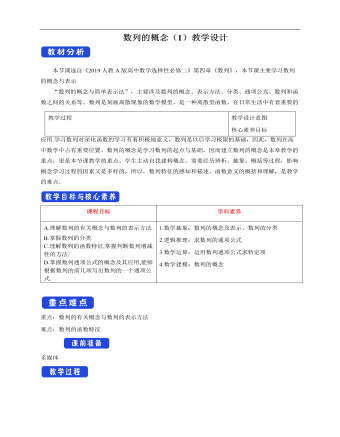
人教版高中数学选择性必修二数列的概念(1)教学设计
情景导学古语云:“勤学如春起之苗,不见其增,日有所长”如果对“春起之苗”每日用精密仪器度量,则每日的高度值按日期排在一起,可组成一个数列. 那么什么叫数列呢?二、问题探究1. 王芳从一岁到17岁,每年生日那天测量身高,将这些身高数据(单位:厘米)依次排成一列数:75,87,96,103,110,116,120,128,138,145,153,158,160,162,163,165,168 ①记王芳第i岁的身高为 h_i ,那么h_1=75 , h_2=87, 〖"…" ,h〗_17=168.我们发现h_i中的i反映了身高按岁数从1到17的顺序排列时的确定位置,即h_1=75 是排在第1位的数,h_2=87是排在第2位的数〖"…" ,h〗_17 =168是排在第17位的数,它们之间不能交换位置,所以①具有确定顺序的一列数。2. 在两河流域发掘的一块泥板(编号K90,约生产于公元前7世纪)上,有一列依次表示一个月中从第1天到第15天,每天月亮可见部分的数:5,10,20,40,80,96,112,128,144,160,176,192,208,224,240. ②
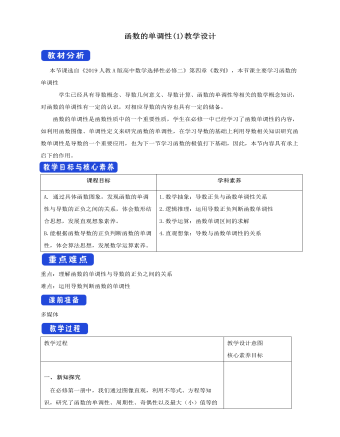
人教版高中数学选择性必修二函数的单调性(1) 教学设计
1.判断正误(正确的打“√”,错误的打“×”)(1)函数f (x)在区间(a,b)上都有f ′(x)<0,则函数f (x)在这个区间上单调递减. ( )(2)函数在某一点的导数越大,函数在该点处的切线越“陡峭”. ( )(3)函数在某个区间上变化越快,函数在这个区间上导数的绝对值越大.( )(4)判断函数单调性时,在区间内的个别点f ′(x)=0,不影响函数在此区间的单调性.( )[解析] (1)√ 函数f (x)在区间(a,b)上都有f ′(x)<0,所以函数f (x)在这个区间上单调递减,故正确.(2)× 切线的“陡峭”程度与|f ′(x)|的大小有关,故错误.(3)√ 函数在某个区间上变化的快慢,和函数导数的绝对值大小一致.(4)√ 若f ′(x)≥0(≤0),则函数f (x)在区间内单调递增(减),故f ′(x)=0不影响函数单调性.[答案] (1)√ (2)× (3)√ (4)√例1. 利用导数判断下列函数的单调性:(1)f(x)=x^3+3x; (2) f(x)=sinx-x,x∈(0,π); (3)f(x)=(x-1)/x解: (1) 因为f(x)=x^3+3x, 所以f^' (x)=〖3x〗^2+3=3(x^2+1)>0所以f(x)=x^3+3x ,函数在R上单调递增,如图(1)所示
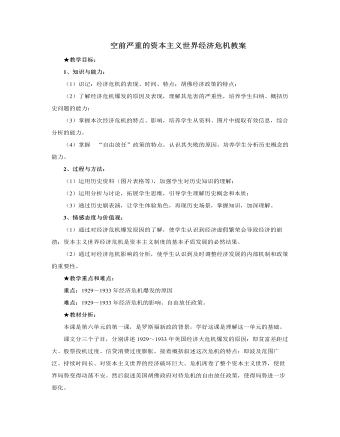
人教版高中历史必修2空前严重的资本主义世界经济危机教案
在美国历史上,很少有像胡佛那样受到老百姓讽刺、憎恶的总统。用破铁罐、纸板和粗麻布搭起来的棚户叫做“胡佛村”,手里提着的装破烂的口袋叫做“胡佛袋”,乡下的贫民把破汽车前部锯掉,套上骨瘦如柴的骡子,叫做“胡佛车” ,在公园长凳上躺着过夜的人用旧报纸裹身取暖,叫做“胡佛毯”,衣袋翻过来,一个钱也找不到,叫做“胡佛旗”,野兔被饥饿的农民抓来吃,叫做“胡佛猪”。杂耍演员插科打诨说:“什么?生意好起来了吗,你的意思是说胡佛死了吧。”★教学反思:本课内容比较条理清楚,旨在说明罗斯福新政实施的背景。备课时考虑将课文顺序进行一下调整,使学生能从较直观的危机的现象进入本课,较易激发学生的兴趣,再来分析原因学生也就比较容易接受。在分析原因时通过材料和课文的阅读,使学生自己通过思考逐步得出结论。而关于胡佛政府的措施的讲述,及问题的提出则可让学生先进行预习,为下一课进入罗斯福新政的学习做好准备。多媒体课件的应用也能使教学活动顺利流畅的进行。
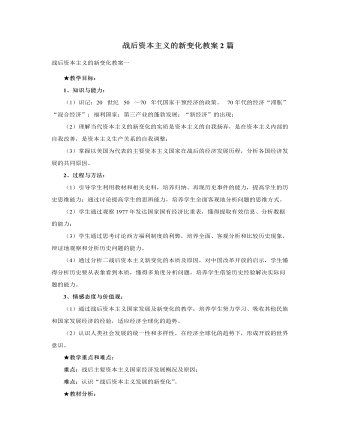
人教版高中历史必修2战后资本主义的新变化教案2篇
1、知识与能力:(1)识记:20 世纪 50 ~70 年代国家干预经济的政策、 70年代的经济“滞胀”“混合经济”;福利国家;第三产业的蓬勃发展;“新经济”的出现;(2)理解当代资本主义的新变化的实质是资本主义的自我扬弃,是在资本主义内部的自我改善,是资本主义生产关系的自我调整;(3)掌握以美国为代表的主要资本主义国家在战后的经济发展历程,分析各国经济发展的共同原因。2、过程与方法:(1)引导学生利用教材和相关史料,培养归纳、再现历史事件的能力,提高学生的历史思维能力;通过讨论提高学生的思辨能力,培养学生全面客观地分析问题的思维方式。(2)学生通过观察1977年发达国家国有经济比重表,懂得提取有效信息、分析数据的能力;(3)学生通过思考讨论西方福利制度的利弊,培养全面、客观分析和比较历史现象,辩证地观察和分析历史问题的能力。
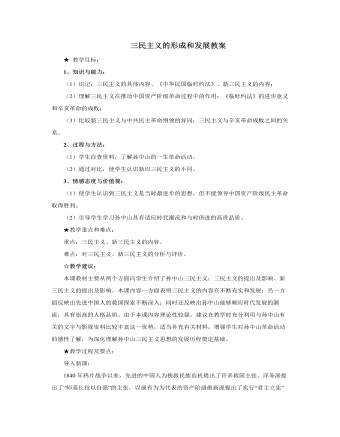
人教版高中历史必修3三民主义的形成和发展教案
局限性:新三民主义在理论上、纲领上仍然没有超出资产阶级民主主义的范畴。且与中共民主革命纲领有着原则的区别。与中共革命纲领相比,新三民主义缺少的内容:八小时工作制、彻底实现人民的权利、社会主义。教学小结:(以问题代小结)(1)本课内容涉及孙中山先生一生两次重要的转变。你知道是哪两次吗?在学生讨论的基础上,教师总结:孙中山先生一生有两次重要的转变,第一次是放弃改良而走向革命道路;第二次是在他领导的一系列资产阶级革命活动失败后,接受苏俄和中共的帮助,把旧三民主义发展成为新三民主义,实行“联俄、联共、扶助农工”三大政策,实现了他一生中最伟大的转变。(2)孙中山先生的这两次转变说明了什么?这一问题可以让学生各抒己见,但教师总结时一定要紧扣孙中山先生与时俱进,为民族革命贡献毕生精力的高贵品质。

人教版新课标高中地理必修2第一章第一节人口的数量变化教案
材料四:印度提倡“只生一个好”——鼓励三人小家庭 生男生女都一样材料五:印度尼西亚《人口发展与幸福家庭法》材料六:我国基本国策 计划生育(小结)通过对以上材料的分析我们可以得出这样的结论,不同的国家应该采取不同的人口政策,对与发达国家来说人口增长缓慢,应采取鼓励生育,吸引移民的措施;发展中国家人口增长较快,实行控制人口的政策已经迫在眉睫。不论是发达国家还是发展中国家共同的目标就是实现环境人口和社会经济的协调发展。【课堂小结】这节课我们主要学习了人口的自然增长,影响人口自然增长的因素有哪些?(人口的自然增长率和人口的基数)世界人口的数量在不同的历史时期表现出不同的特征,同一历史时期的不同地区,人口数量的增长又有不同的特点。面对不同的人口形势,各国应采取不同的人口政策。
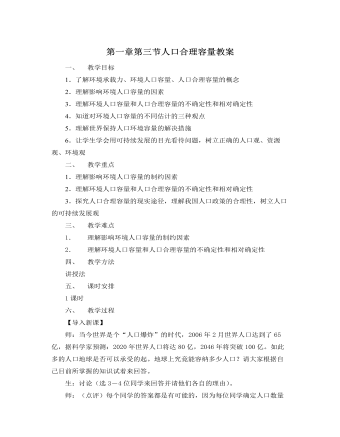
人教版新课标高中地理必修2第一章第三节人口合理容量教案
生:环境承载力是指环境能持续供养的人口数量。师:对了。但是有同学仍然会感到这是一个很抽象的概念。下面我们具体来了解什么是环境承载力。我们可以从两个部分去理解:一、环境,它主要是指环境的单个要素(如:土地、水、气候、植被等。)及其组合方式。二、是承载力,它指在特定的条件下,具体某事物能承受的某种活动的最大值。那环境承载力的科学定义是怎样表达的呢?生:环境承载力是指某一时期,某种状态条件下,某地区环境所能承受的人类活动作用的阈值。师:很对。 我们可以用一个生动的例子来说明。一只木桶里面的水的多少在底面积固定不变的情况下是由哪块木板来决定?生:最短的那块。师:确实如此。这就是我们平常所讲的 “木桶效应”。那影响环境承载力的大小也是由环境个要素里面最紧缺的那个要素来决定的。下面我们用一个例子来印证一下。
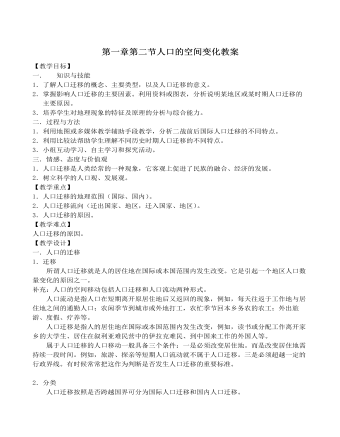
人教版新课标高中地理必修2第一章第二节人口的空间变化教案
1.促使美国成为一个移民国家的因素是:①美洲属于未开发的新大陆,需要大量的劳动力;②欧洲失业工人和破产农民增加,人们为了追求更好的经济待遇迁往美洲;③新航线的开辟为人们顺利迁移扫除了障碍;④殖民扩张是人口迁移的促进因素,加快了人口迁移的过程。导致美国人口在本土范围内频繁迁移的原因,归纳起来有:第一次人口迁移是战争因素,第二次是城市化;第三次是自然环境、经济环境的变化;第四次是经济格局的变化,即西部和南部新资源的发现和新兴工业的发展。2.我国古代的人口迁移,深受统治者及其行政力量的束缚。封建帝王为了加强本国的经济和军事实力,对人口迁移严加控制。只有当战乱发生的时候,这种控制才得到削弱,人们为了躲避战乱,寻找安定的生活环境,不得不进行大规模的迁移。我国近几十年的人口迁移主要是由生产资料和劳动力数量上的地区分布不平衡造成的,是经济因素在起主导作用,与古代的人口迁移截然不同。
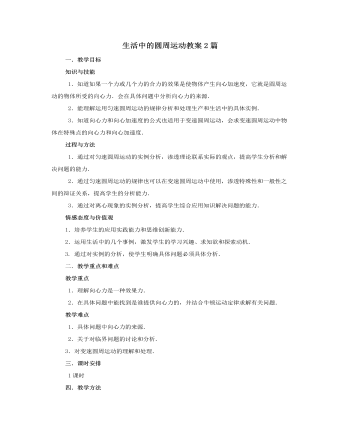
人教版新课标高中物理必修2生活中的圆周运动教案2篇
思考:洗衣机脱水时转速高时容易甩干衣物,还是转速低时容易甩干衣物?(2) 制作棉花糖的原理内筒与洗衣机的脱水筒相似,里面加入白砂糖,加热使糖熔化成糖汁。内筒高速旋转,黏稠的糖汁就做离心运动,从内筒壁的小孔飞散出去,成为丝状到达温度较低的外筒,并迅速冷却凝固,变得纤细雪白,像一团团棉花。5.离心现象的防止在水平公路上行驶的汽车,转弯时所需的向心力是由车轮与路面的静摩擦力提供的。如果转弯时速度过大,所需向心力F大于最大静摩擦力Fmax,汽车将做离心运动而造成交通事故。因此,在公路弯道处,车辆行驶不允许超过规定的速度。当高速转动的砂轮或者飞轮内部分子间相互作用力不足以提供所需向心力时,离心运动就会使他们破裂,甚至酿成事故。
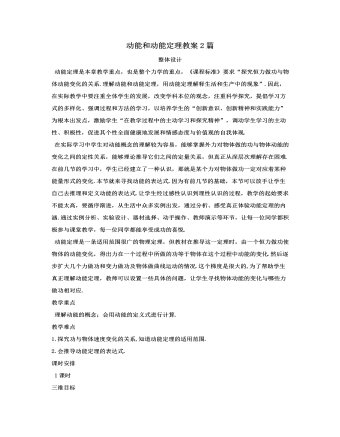
人教版新课标高中物理必修2动能和动能定理教案2篇
二、课堂教学(课前由科代表发回预习学案)1、教师根据预习学案检查结果提出问题(用多媒体展示),引导全班讨论(重点讨论:①、为什么动能的表达式一定是 mV2 ?你如何得出这个结论?②、力在一个过程中对物体所做的功,和物体在这个过程中动能的变化量有什么关系?你如何得出这个结论?这个做功的力和F=ma中的力F有什么关系)。有困难的小组应及时问老师。老师在这个过程中巡视指导。2、学生自主阅读课文“7 动能和动能定理”中的“动能的表达式”,然后完成如下练习(教师在此过程中巡视指导):2.1尝试推出动能的表达式(鼓励会推导的同学积极上台板演,老师引导讨论)。2.2写出动能的小结(认真阅读教材p66倒数第二段、第三段,结合你推导动能表达式的过程,认真思考后四人一组讨论:①、动能是矢量还是标量?②、动能的单位是什么?③、你认为应从哪几方面来理解动能?)
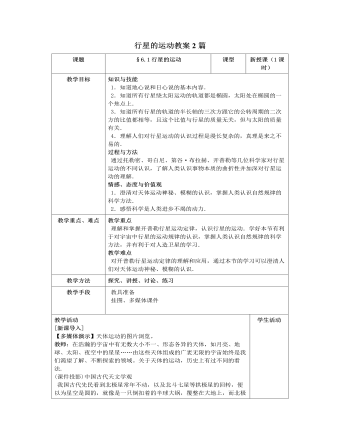
人教版新课标高中物理必修2行星的运动教案2篇
知识与技能1.知道地心说和日心说的基本内容.2.知道所有行星绕太阳运动的轨道都是椭圆,太阳处在椭圆的一个焦点上.3.知道所有行星的轨道的半长轴的三次方跟它的公转周期的二次方的比值都相等,且这个比值与行星的质量无关,但与太阳的质量有关.4.理解人们对行星运动的认识过程是漫长复杂的,真理是来之不易的.过程与方法通过托勒密、哥白尼、第谷·布拉赫、开普勒等几位科学家对行星运动的不同认识,了解人类认识事物本质的曲折性并加深对行星运动的理解.情感、态度与价值观1.澄清对天体运动裨秘、模糊的认识,掌握人类认识自然规律的科学方法.2.感悟科学是人类进步不竭的动力.教学重点理解和掌握开普勒行星运动定律,认识行星的运动.学好本节有利于对宇宙中行星的运动规律的认识,掌握人类认识自然规律的科学方法,并有利于对人造卫星的学习.

人教版新课标高中物理必修2研究平抛运动教案3篇
(给出仪器后先让学生思考如何设计实验、安装仪器、设计实验步骤,而后教师总结)实验步骤如下:①安装调整斜槽 :用图钉把白纸钉在竖直板上,在木板的左上角固定斜槽。②调整木板 :用悬挂在槽口的重锤线把木板调整到竖直方向,并使木板平面与小球下落的竖直面平行,然后把重锤线方向记录到钉在木板上的白纸上,固定木板,使在重复实验的过程中,木板与斜槽的相对位置保持不变。③确定坐标原点:把小球放在槽口处,用铅笔记下小球在槽口时球心在木板上的水平投影点O,O即为坐标原点。④描绘运动轨迹 :用铅笔的笔尖轻轻地靠在木板的平面上,不断调整笔尖的位置,使从斜槽上滚下的小球正好碰到笔尖,然后就用铅笔在该处白纸上点上一个黑点,这就记下了小球球心所对应的位置。保证小球每次从槽上开始滚下的位置都相同,用同样的方法可找出小球平抛轨迹上的一系列位置。取下白纸,描绘小球做平抛运动的轨迹。
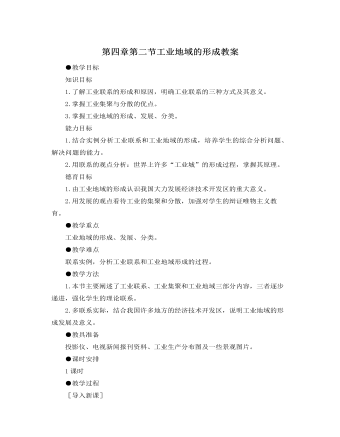
人教版新课标高中地理必修2第四章第二节工业地域的形成教案
在经济水平较高、工业地域规模较大的地区,其发展潜力就远不一样,如钢铁工业。钢铁工业的生产过程比较复杂(如课本图5.31),需要有相互接近的工厂,不仅包括从事钢铁生产各道工序的工厂,如烧结厂、焦化厂、炼铁厂、炼钢厂、轧钢厂,还包括与钢铁生产有联系的工厂,如氧气厂、机修厂、发电厂、水泥厂等,总共可达20~30个工厂。这些工厂集 聚,设备大,管线长,占地多。因此,这样形成的工业地域(钢铁工业区)面积广,发育程度高,发展潜力大。这类工业地域 再加上为方便众多工人生活所配置的服务业和其他工业,在发展过程中,往往由于工业地域的扩展而形成工业城市。例如,我国的鞍山(“钢都”)、攀枝花、马鞍山、包头(“草原钢城”)等钢铁工业城市的形成。除此之外,石油化工区、机械制造工业区等属于发育程度高的工业地域,也往往扩展而形成工业城市。例如,我国的石油城大庆、克拉玛依,汽车城十堰等。
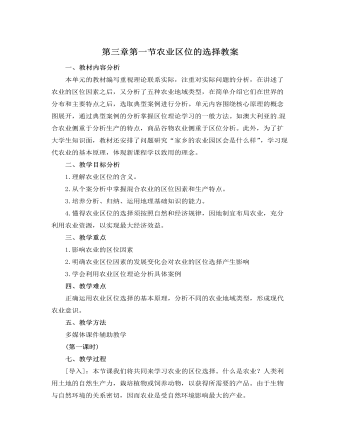
人教版新课标高中地理必修2第三章第一节农业区位的选择教案
1.澳大利亚混合农业地域在生产结构、经营方式、科技应用、农业专业化和地域化等方面有哪些特点?2.在澳大利亚混合农业地 域形成的过程中,有哪些区位因素在起作用?学生发言,教师适当引导、评点并作讲解。[教师提问]:那么,澳大利亚的墨累—达令盆地的区位因素有什么不足之处?知识拓展:课件展示澳大利亚大分水岭的雨影效应的形成原理及东水西调示意图。[教师讲解]:澳大利亚东南部受大分水岭的影响,降水集中于大分水岭的东侧,在其西侧形成山地的雨影效应,降水丰富地区与农业生产地区分布不一致,灌溉成为澳大利亚农牧业发展的限制性条件。因此,澳大利亚对水利工程建设很 重视,东水西调促进了墨累—达令盆地农牧业的发展。[课堂小结]:这节课我们学习了农业区位选择的基本原理。 通过学习我们了解到,农业的区位选择实质上就是对农业土地的合理利用。
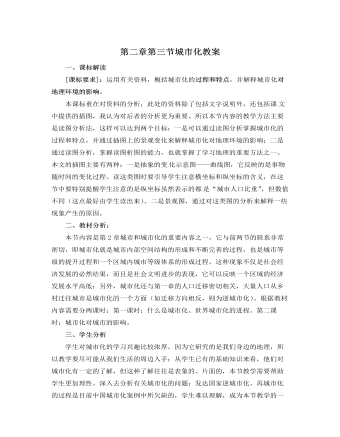
人教版新课标高中地理必修2第二章第三节城市化教案
[补充]:郑州是特大城市,我们对灯火通明的夜晚都有深刻的体会,我们都体会过光给他们带来的好处,而对过多过亮的光带来的危害则很少认真地思考过,且光污染给都市人们和其他生物和环境带来的不利影响也越来越大,所以,我在这儿给同学们补充光污染,目的是提醒他们要增强环保意识,要理解城市在建设过程中要减少城市各类活动对环境的污染;另外,随着城市的不断发展,还可能会产生新 的污染物。还培养了学生用发展的眼光来看世界。[思考]:如何降低城市化对地理环境产生的影响?[答]:发展生态城市,使人工环境和自然环境和谐统一起来。一方面在城市建设中,要发展低污染的节能建筑和绿色交通,减少城市各类活动对环境的污染;另一方面使城市景观尽可能地与山、河、湖、海、植被等自然景观保持协调,建立一种良性循环。
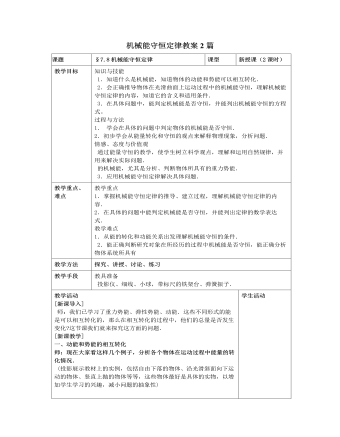
人教版新课标高中物理必修2机械能守恒定律教案2篇
(二)进行新课1、动能与势能的相互转化演示实验1:如右图,用细线、小球、带有标尺的铁架台等做实验。把一个小球用细线悬挂起来,把小球拉到一定高度的A点,然后放开,小球在摆动过程中,重力势能和动能相互转化。我们看到,小球可以摆到跟A点等高的C点,如图甲。如果用尺子在某一点挡住细线,小球虽然不能摆到C点,但摆到另一侧时,也能达到跟A点相同的高度,如图乙。问题:这个小实验中,小球的受力情况如何?各个力的做功情况如何?这个小实验说明了什么?学生观察演示实验,思考问题,选出代表发表见解。小球在摆动过程中受重力和绳的拉力作用。拉力和速度方向总垂直,对小球不做功;只有重力对小球能做功。实验证明,小球在摆动过程中重力势能和动能在不断转化。在摆动过程中,小球总能回到原来的高度。可见,重力势能和动能的总和保持不变。即机械能保持不变。
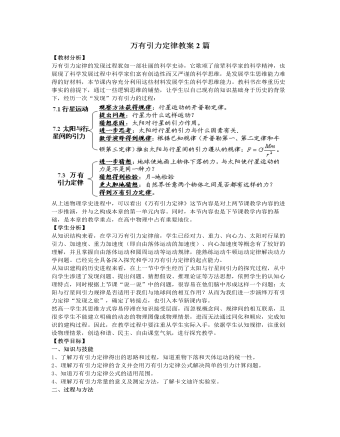
人教版新课标高中物理必修2万有引力定律教案2篇
3.适用条件(1)万有引力定律只适用于质点间引力大小的计算。当两物体间的距离远远大于每个物体的尺寸时,物体可以看成质点,直接使用万有引力定律计算。(模型)研究相互接触的两个人之间的万有引力时,不能把他们看作质点。(2)当两物体是质量均匀分布的球体时,它们间的引力也可直接用公式计算,但式中的r是指两球心间距离。研究太阳和地球之间的万有引力,可以把它们看作质量均匀的球体。当研究物体不能看成质点时,可以把物体假想分割成无数个质点,求出两个物体上每个质点与另一物体上所有质点的万有引力,然后求合力,这是微积分的思想。万有引力定律产生于对太阳系行星运动的研究,但它对物质运动的适用性却要广泛得多。可以这样说,宇宙中凡有引力参与的一切复杂的现象,无不要归结到这样一条十分简洁的定律之中,这不能不使人惊叹宇宙万物超乎寻常的和谐及人类理性思考所具有的统摄力。

人教版新课标高中物理必修2太阳与行星间的引力教案2篇
【学习内容分析】在行星运动规律与万有引力定律两节内容之间安排本节内容,是为了更突出发现万有引力定律的这个科学过程。如果说上一节内容是从运动学角度描述行星运动的话,那么,本节内容是从动力学角度来研究行星运动的,研究过程是依据已有规律进行的演绎推理过程。教科书在尊重历史事实的前提下,通过一些逻辑思维的铺垫,让学生以自己现有的知识基础身于历史的背景下,经历一次“发现”万有引力的过程,因此体验物理学研究问题的方法就成为主要的教学目标。【学情分析】在学太阳对行星的引力之前,学生已经对力、重力、向心力、加速度、重力加速度、向心加速度等概念有了较好的理解,并且掌握自由落体运动和圆周运动等运动规律,能熟练运用牛顿运动定律解决动力学问题。已经完全具备深入探究和学习万有引力定律的起点能力。所以在推导太阳与行星运动规律时,教师可以要求学生自主地运用原有的知识进行推导,并要求说明每一步推理的理论依据是什么,教师仅在难点问题上做适当的点拨。
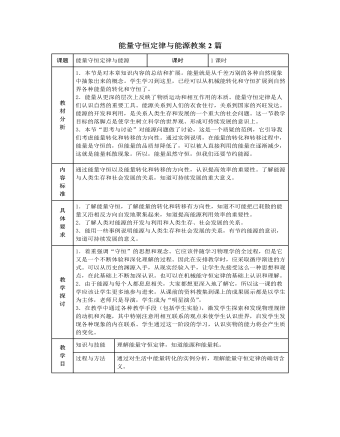
人教版新课标高中物理必修2能量守恒定律与能源教案2篇
世界能源问题的解决途径是什么?能源,是人类敕以生存和进行生产的不可缺少的资源.近年来,随着生产力的发展和能源消费的增长.能源问题已被列为世界上研究的重大问题之一.解决世界能源问题的根本途径,主要有两个方面:其一是广泛开源,其二是认真节流.所谓开源,就是积极开发和利用各种能源.在继续加紧石油勘探和寻找新的石油产地的同时,积极开发丰富的煤炭资源,还要大力开发水能,生物能等常规能源,加强核能、太阳能,风能、沼气,海洋能,地热能以及其他各种新能源的研究和利用,从而不断扩大人类的能源资源的种类和来源.所谓节流,就是要大力提倡节约能源.节能是世界上许多国家关心和研究的重要课题,甚至有人把节能称为世界的“第五大能源”,与煤、石油和天然气、水能、核能等并列.在节能方面,在有计划地控制人口增长的同时,重点要发挥先进科学技术的优势,提高各国的能源利用效率.
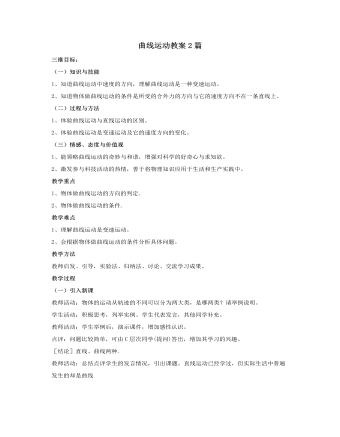
人教版新课标高中物理必修2曲线运动教案2篇
1、教师先演示投影:把小钢珠放在黑墨水瓶盖里转一下(内有一点点墨水),再放在半圆形有机玻璃轨道上运动并飞出,让钢珠在白纸上留下痕迹,同样在3/5半圆周,4/5半圆周上运动飞出,让学生猜测飞出方向由什么特点?(有机玻璃板说明:厚约5毫米,略小于小钢珠直径,圆弧半径15厘米,MN边稍长些,以便过MN做直线,根据半径大小确定圆心O位置。)学生猜想:切线方向师:已知圆弧半径为15厘米。如何验证?请用几何方法作图验证。生:标出飞出点和圆心,做圆心和飞出点的连线,用量角尺量出该连线和飞出轨迹直线的夹角,是否90度。2、再分组实验,提醒同桌配合,小心钢珠滚跑。实验完毕,要求作图验证,并互相讨论交流。3、交流和结论:师:要引导学生得出正确的科学结论:“圆周运动的物体的速度方向为该点的切线方向”,而不能直接得出“曲线运动的的物体速度方向为该点的切线方向”。





















